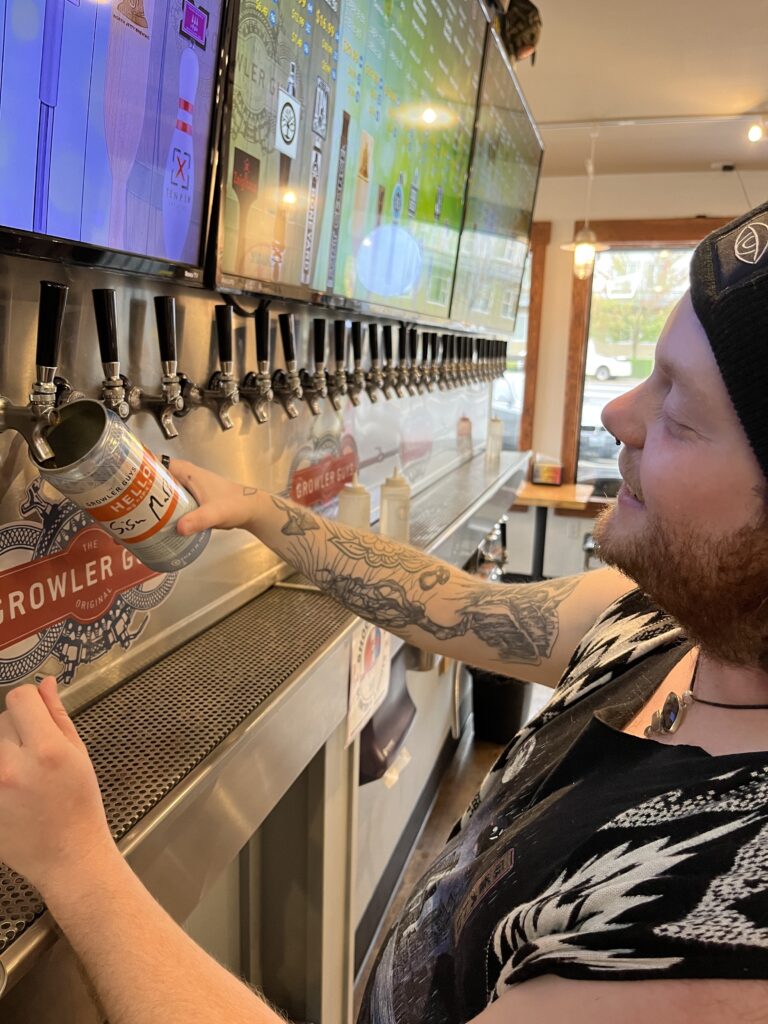Pity the growler.
The big brown glass jug that’s been a symbol of craft brewing for decades is in the midst of a slow fade. Fewer customers are bringing them in for 64-ounce refills. Many breweries aren’t bothering to sell them anymore.
Traditional growlers are typically emblazoned with the logo of the brewery, making them an enduring expression of customer loyalty as well as a vessel used to store draft beer.
The idea has always been to stick the jug in the fridge and have enough fresh brew for the weekend, or bring one or two to a party and watch the beer fans come running.
So, what happened to turn the once-hip growler into a dusty relic?
The crowler came along.
A large aluminum can that’s filled and vacuum-sealed at the brewpub or taproom, crowlers hold 32 ounces, making them lighter, more compact and easier to tote around. They also preserve freshness longer, experts agree.

Beer in a crowler remains fresh for a couple of weeks, or until the can is opened. The quality of beer in a glass container can suffer even if unopened due to light exposure. And once the cap is unscrewed, watch out. The brew will rapidly lose carbonation and flavor, connoisseurs say.
Other crowler advantages over growlers: You don’t have to buy one, clean it after every use, remember to lug it to the brewery or worry about breakage.
Most breweries now have simple countertop machines that seal crowlers on demand. The name of the beer and the date are written with a permanent marker on the front of the can.
At The Growler Guys in Astoria, which boasts 42 beers on tap, the trend has been clear. Despite the old school business name, far more crowlers are being filled than growlers these days, according to beertender Janick Langley-Williams.
What’s more, customers in their 20s and 30s favor the big aluminum cans. The growler crowd definitely skews older, he says.

Obelisk Beer Co., Astoria’s newest brewery, doesn’t sell growlers. Instead, there’s a crowler machine beside the taps.
Obelisk beertender Kathleen Rooen says occasionally someone will bring in a growler from somewhere else and she’ll fill it with a heavy heart, wondering how much of the beer will wind up flat and undrinkable.
Rooen has found that the quality of the beer starts degrading when the cap comes off, so if you buy a growler fill on Friday afternoon and have a drink that night, don’t expect fresh beer on Sunday.
“They don’t seal properly, so it creates a lot of waste,” she says. “They’re out. They’re collectibles now.”
Josh Allison, head brewer and founder of Reach Break Brewing in downtown Astoria, agrees.
“There’s not really any downside to them,” he says of crowlers. “They seal better, preserve the beer better, and they don’t break. Right now, glass growlers are pretty much dead.”
Historically, growlers have been around for a very long time. A covered tin pail was used in the late 1800s. According to legend, the name came from the sound escaping carbon dioxide made as the brew sloshed around on the walk home from the pub.
In recent years, the growler’s decline is linked to the movement away from glass bottles in craft brewing (exception: special, barrel-aged releases) and the embrace of aluminum cans that are less expensive to buy and ship, and harder to damage.
Even seasonal beers that used to be draft-only tend to be canned today, further eroding the value of the big jug.
Some smaller breweries with an older clientele are resisting the trend. North Jetty Brewing Co. in Seaview, Wash., for instance, has been offering a special day in the taproom when growler refills are discounted.
Over the years, there have been attempts at innovation, with modern growlers available in stainless steel. There’s even an expensive pressurized version that functions like a mini keg.
But that classic jug with the moonshiner’s handle?
Sadly, it’s bound for either a recycling bin, rec room shelf or antique store.
This column originally appeared Nov. 7 in The Astorian.




